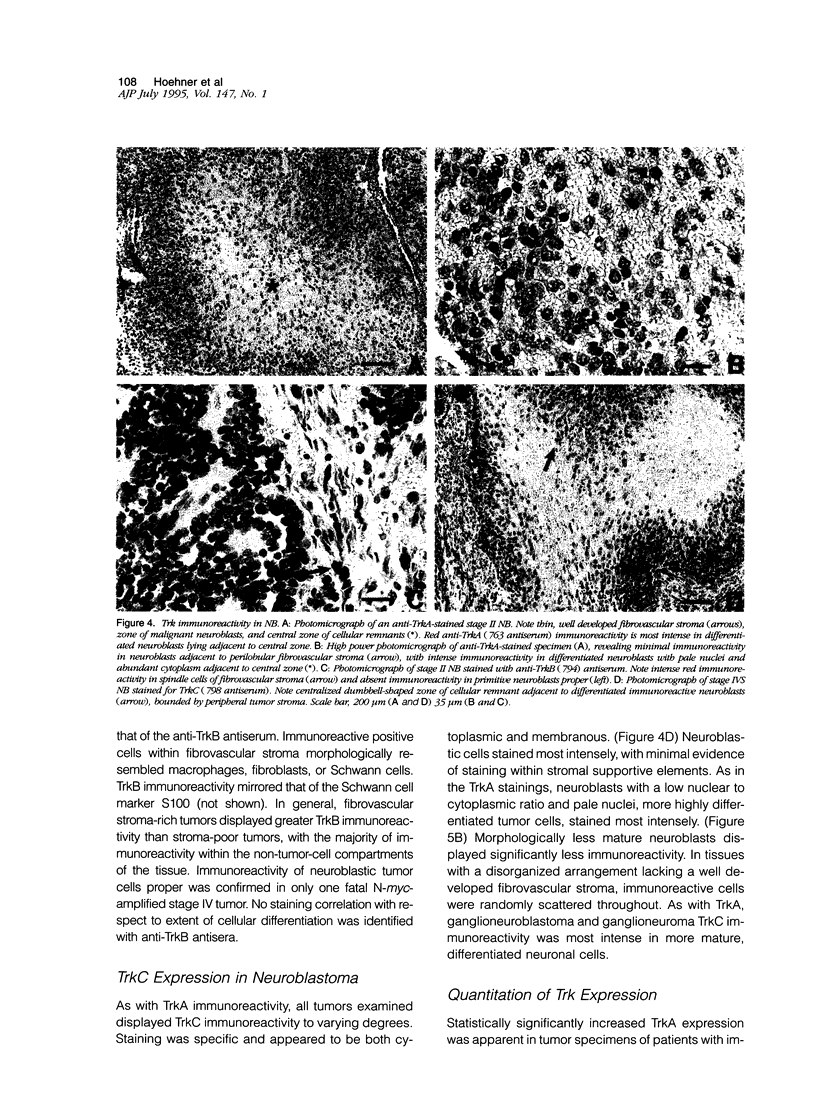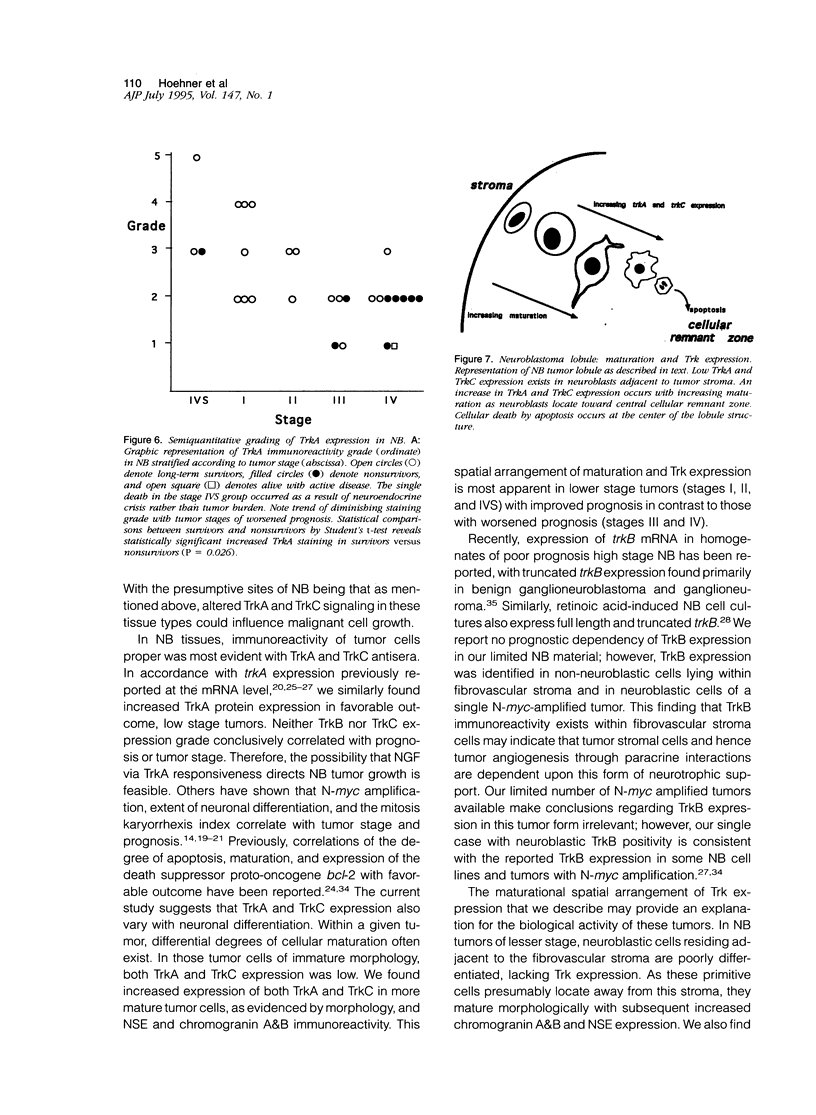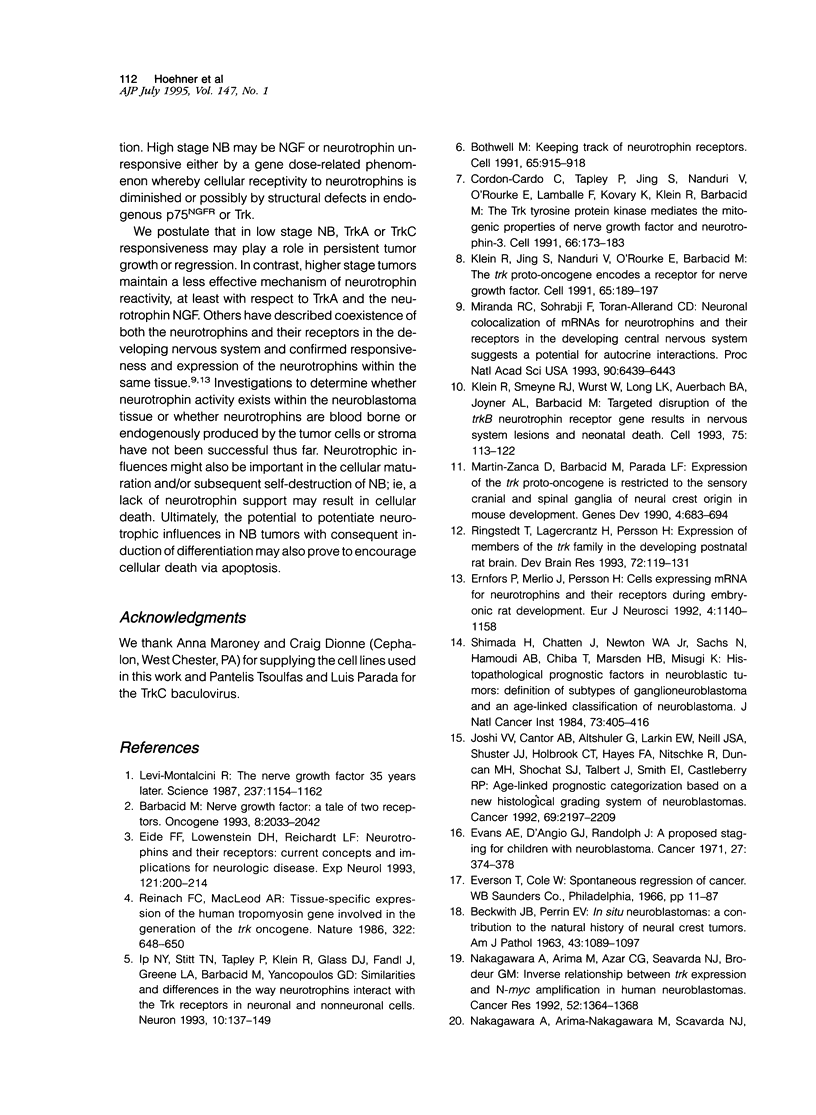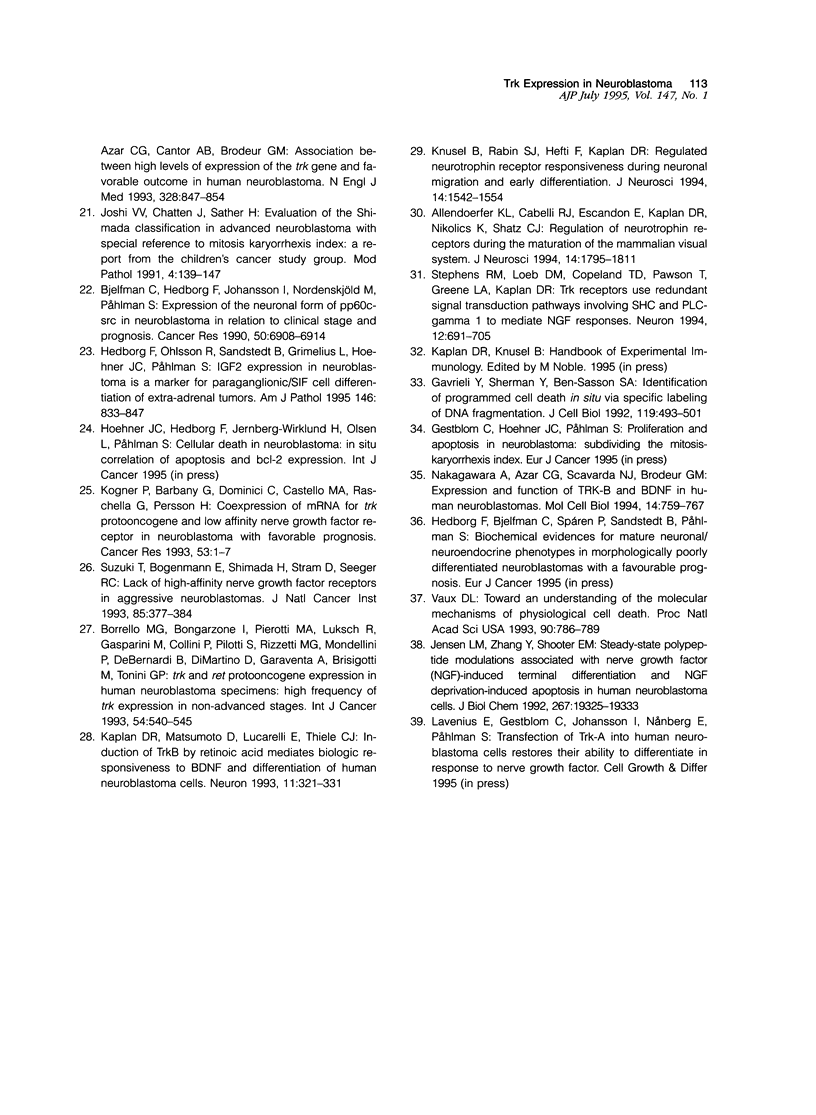Abstract
Interactions of the trk family of tyrosine kinase receptors with neurotrophins result in growth and maturational changes in neuronal cells. The continued progression, maturation, or regression of neuroblastoma, an embryonal, sympathetic nervous system-derived tumor of infants and children, might be governed by neurotrophic influences. Immunocytochemistry was utilized to evaluate TrkA, TrkB, and TrkC protein expression at the cellular level in the developing human fetal sympathetic nervous system and in a selection of neuroblastoma tumor specimens. TrkA and TrkC expression was identified in sympathetic ganglia and within the adrenal medulla, with intense TrkB expression restricted to paraganglia, of the normal developing human sympathetic nervous system. In neuroblastoma, pp140trkA expression correlated positively with favorable tumor stage (P = 0.0027) and favorable outcome (P = 0.026). No statistically significant correlation of TrkC expression with outcome was evident; however, both TrkA and TrkC expression was most apparent in tumor cells of increased differentiation. TrkB expression was primarily localized to cells within the fibrovascular tumor stroma. A model of neurotrophin receptor expression and neurotrophin reactivity with differentiation is proposed. The existence and spatial distribution of neurotrophin receptors in neuroblastoma lend supportive evidence that neurotrophic influences may be involved in tumor persistence or regression.
Full text
PDF











Images in this article
Selected References
These references are in PubMed. This may not be the complete list of references from this article.
- Allendoerfer K. L., Cabelli R. J., Escandón E., Kaplan D. R., Nikolics K., Shatz C. J. Regulation of neurotrophin receptors during the maturation of the mammalian visual system. J Neurosci. 1994 Mar;14(3 Pt 2):1795–1811. doi: 10.1523/JNEUROSCI.14-03-01795.1994. [DOI] [PMC free article] [PubMed] [Google Scholar]
- BECKWITH J. B., PERRIN E. V. IN SITU NEUROBLASTOMAS: A CONTRIBUTION TO THE NATURAL HISTORY OF NEURAL CREST TUMORS. Am J Pathol. 1963 Dec;43:1089–1104. [PMC free article] [PubMed] [Google Scholar]
- Barbacid M. Nerve growth factor: a tale of two receptors. Oncogene. 1993 Aug;8(8):2033–2042. [PubMed] [Google Scholar]
- Bjelfman C., Hedborg F., Johansson I., Nordenskjöld M., Påhlman S. Expression of the neuronal form of pp60c-src in neuroblastoma in relation to clinical stage and prognosis. Cancer Res. 1990 Nov 1;50(21):6908–6914. [PubMed] [Google Scholar]
- Borrello M. G., Bongarzone I., Pierotti M. A., Luksch R., Gasparini M., Collini P., Pilotti S., Rizzetti M. G., Mondellini P., De Bernardi B. trk and ret proto-oncogene expression in human neuroblastoma specimens: high frequency of trk expression in non-advanced stages. Int J Cancer. 1993 Jun 19;54(4):540–545. doi: 10.1002/ijc.2910540404. [DOI] [PubMed] [Google Scholar]
- Bothwell M. Keeping track of neurotrophin receptors. Cell. 1991 Jun 14;65(6):915–918. doi: 10.1016/0092-8674(91)90540-f. [DOI] [PubMed] [Google Scholar]
- Cordon-Cardo C., Tapley P., Jing S. Q., Nanduri V., O'Rourke E., Lamballe F., Kovary K., Klein R., Jones K. R., Reichardt L. F. The trk tyrosine protein kinase mediates the mitogenic properties of nerve growth factor and neurotrophin-3. Cell. 1991 Jul 12;66(1):173–183. doi: 10.1016/0092-8674(91)90149-s. [DOI] [PMC free article] [PubMed] [Google Scholar]
- Eide F. F., Lowenstein D. H., Reichardt L. F. Neurotrophins and their receptors--current concepts and implications for neurologic disease. Exp Neurol. 1993 Jun;121(2):200–214. doi: 10.1006/exnr.1993.1087. [DOI] [PubMed] [Google Scholar]
- Ernfors Patrik, Merlio Jean-Phillipe, Persson Håkan. Cells Expressing mRNA for Neurotrophins and their Receptors During Embryonic Rat Development. Eur J Neurosci. 1992 Oct;4(11):1140–1158. doi: 10.1111/j.1460-9568.1992.tb00141.x. [DOI] [PubMed] [Google Scholar]
- Evans A. E., D'Angio G. J., Randolph J. A proposed staging for children with neuroblastoma. Children's cancer study group A. Cancer. 1971 Feb;27(2):374–378. doi: 10.1002/1097-0142(197102)27:2<374::aid-cncr2820270221>3.0.co;2-g. [DOI] [PubMed] [Google Scholar]
- Gavrieli Y., Sherman Y., Ben-Sasson S. A. Identification of programmed cell death in situ via specific labeling of nuclear DNA fragmentation. J Cell Biol. 1992 Nov;119(3):493–501. doi: 10.1083/jcb.119.3.493. [DOI] [PMC free article] [PubMed] [Google Scholar]
- Hedborg F., Ohlsson R., Sandstedt B., Grimelius L., Hoehner J. C., Pählman S. IGF2 expression is a marker for paraganglionic/SIF cell differentiation in neuroblastoma. Am J Pathol. 1995 Apr;146(4):833–847. [PMC free article] [PubMed] [Google Scholar]
- Horio Y., Takahashi T., Kuroishi T., Hibi K., Suyama M., Niimi T., Shimokata K., Yamakawa K., Nakamura Y., Ueda R. Prognostic significance of p53 mutations and 3p deletions in primary resected non-small cell lung cancer. Cancer Res. 1993 Jan 1;53(1):1–4. [PubMed] [Google Scholar]
- Ip N. Y., Stitt T. N., Tapley P., Klein R., Glass D. J., Fandl J., Greene L. A., Barbacid M., Yancopoulos G. D. Similarities and differences in the way neurotrophins interact with the Trk receptors in neuronal and nonneuronal cells. Neuron. 1993 Feb;10(2):137–149. doi: 10.1016/0896-6273(93)90306-c. [DOI] [PubMed] [Google Scholar]
- Jensen L. M., Zhang Y., Shooter E. M. Steady-state polypeptide modulations associated with nerve growth factor (NGF)-induced terminal differentiation and NGF deprivation-induced apoptosis in human neuroblastoma cells. J Biol Chem. 1992 Sep 25;267(27):19325–19333. [PubMed] [Google Scholar]
- Joshi V. V., Cantor A. B., Altshuler G., Larkin E. W., Neill J. S., Shuster J. J., Holbrook C. T., Hayes F. A., Nitschke R., Duncan M. H. Age-linked prognostic categorization based on a new histologic grading system of neuroblastomas. A clinicopathologic study of 211 cases from the Pediatric Oncology Group. Cancer. 1992 Apr 15;69(8):2197–2211. doi: 10.1002/1097-0142(19920415)69:8<2197::aid-cncr2820690829>3.0.co;2-x. [DOI] [PubMed] [Google Scholar]
- Joshi V. V., Chatten J., Sather H. N., Shimada H. Evaluation of the Shimada classification in advanced neuroblastoma with a special reference to the mitosis-karyorrhexis index: a report from the Childrens Cancer Study Group. Mod Pathol. 1991 Mar;4(2):139–147. [PubMed] [Google Scholar]
- Kaplan D. R., Matsumoto K., Lucarelli E., Thiele C. J. Induction of TrkB by retinoic acid mediates biologic responsiveness to BDNF and differentiation of human neuroblastoma cells. Eukaryotic Signal Transduction Group. Neuron. 1993 Aug;11(2):321–331. doi: 10.1016/0896-6273(93)90187-v. [DOI] [PubMed] [Google Scholar]
- Klein R., Jing S. Q., Nanduri V., O'Rourke E., Barbacid M. The trk proto-oncogene encodes a receptor for nerve growth factor. Cell. 1991 Apr 5;65(1):189–197. doi: 10.1016/0092-8674(91)90419-y. [DOI] [PubMed] [Google Scholar]
- Klein R., Smeyne R. J., Wurst W., Long L. K., Auerbach B. A., Joyner A. L., Barbacid M. Targeted disruption of the trkB neurotrophin receptor gene results in nervous system lesions and neonatal death. Cell. 1993 Oct 8;75(1):113–122. [PubMed] [Google Scholar]
- Knüsel B., Rabin S. J., Hefti F., Kaplan D. R. Regulated neurotrophin receptor responsiveness during neuronal migrationand early differentiation. J Neurosci. 1994 Mar;14(3 Pt 2):1542–1554. doi: 10.1523/JNEUROSCI.14-03-01542.1994. [DOI] [PMC free article] [PubMed] [Google Scholar]
- Levi-Montalcini R. The nerve growth factor 35 years later. Science. 1987 Sep 4;237(4819):1154–1162. doi: 10.1126/science.3306916. [DOI] [PubMed] [Google Scholar]
- Martin-Zanca D., Barbacid M., Parada L. F. Expression of the trk proto-oncogene is restricted to the sensory cranial and spinal ganglia of neural crest origin in mouse development. Genes Dev. 1990 May;4(5):683–694. doi: 10.1101/gad.4.5.683. [DOI] [PubMed] [Google Scholar]
- Miranda R. C., Sohrabji F., Toran-Allerand C. D. Neuronal colocalization of mRNAs for neurotrophins and their receptors in the developing central nervous system suggests a potential for autocrine interactions. Proc Natl Acad Sci U S A. 1993 Jul 15;90(14):6439–6443. doi: 10.1073/pnas.90.14.6439. [DOI] [PMC free article] [PubMed] [Google Scholar]
- Nakagawara A., Arima-Nakagawara M., Scavarda N. J., Azar C. G., Cantor A. B., Brodeur G. M. Association between high levels of expression of the TRK gene and favorable outcome in human neuroblastoma. N Engl J Med. 1993 Mar 25;328(12):847–854. doi: 10.1056/NEJM199303253281205. [DOI] [PubMed] [Google Scholar]
- Nakagawara A., Arima M., Azar C. G., Scavarda N. J., Brodeur G. M. Inverse relationship between trk expression and N-myc amplification in human neuroblastomas. Cancer Res. 1992 Mar 1;52(5):1364–1368. [PubMed] [Google Scholar]
- Nakagawara A., Azar C. G., Scavarda N. J., Brodeur G. M. Expression and function of TRK-B and BDNF in human neuroblastomas. Mol Cell Biol. 1994 Jan;14(1):759–767. doi: 10.1128/mcb.14.1.759. [DOI] [PMC free article] [PubMed] [Google Scholar]
- Reinach F. C., MacLeod A. R. Tissue-specific expression of the human tropomyosin gene involved in the generation of the trk oncogene. Nature. 1986 Aug 14;322(6080):648–650. doi: 10.1038/322648a0. [DOI] [PubMed] [Google Scholar]
- Ringstedt T., Lagercrantz H., Persson H. Expression of members of the trk family in the developing postnatal rat brain. Brain Res Dev Brain Res. 1993 Mar 19;72(1):119–131. doi: 10.1016/0165-3806(93)90165-7. [DOI] [PubMed] [Google Scholar]
- Shimada H., Chatten J., Newton W. A., Jr, Sachs N., Hamoudi A. B., Chiba T., Marsden H. B., Misugi K. Histopathologic prognostic factors in neuroblastic tumors: definition of subtypes of ganglioneuroblastoma and an age-linked classification of neuroblastomas. J Natl Cancer Inst. 1984 Aug;73(2):405–416. doi: 10.1093/jnci/73.2.405. [DOI] [PubMed] [Google Scholar]
- Stephens R. M., Loeb D. M., Copeland T. D., Pawson T., Greene L. A., Kaplan D. R. Trk receptors use redundant signal transduction pathways involving SHC and PLC-gamma 1 to mediate NGF responses. Neuron. 1994 Mar;12(3):691–705. doi: 10.1016/0896-6273(94)90223-2. [DOI] [PubMed] [Google Scholar]
- Suzuki T., Bogenmann E., Shimada H., Stram D., Seeger R. C. Lack of high-affinity nerve growth factor receptors in aggressive neuroblastomas. J Natl Cancer Inst. 1993 Mar 3;85(5):377–384. doi: 10.1093/jnci/85.5.377. [DOI] [PubMed] [Google Scholar]
- Vaux D. L. Toward an understanding of the molecular mechanisms of physiological cell death. Proc Natl Acad Sci U S A. 1993 Feb 1;90(3):786–789. doi: 10.1073/pnas.90.3.786. [DOI] [PMC free article] [PubMed] [Google Scholar]








